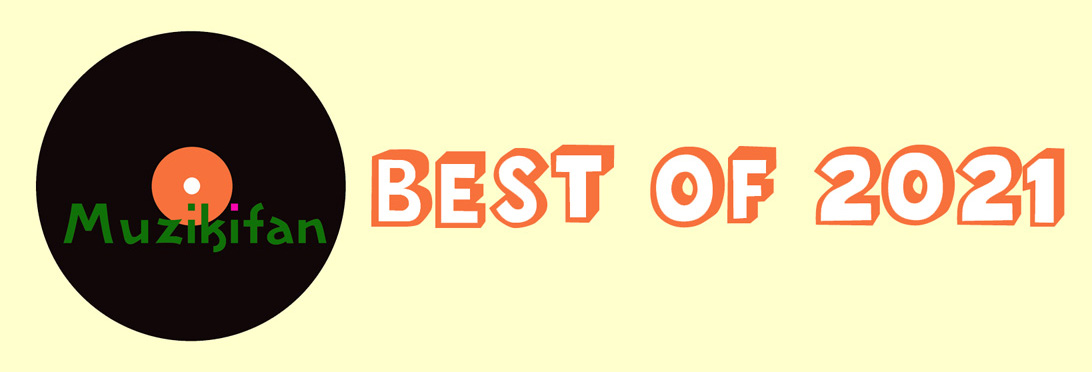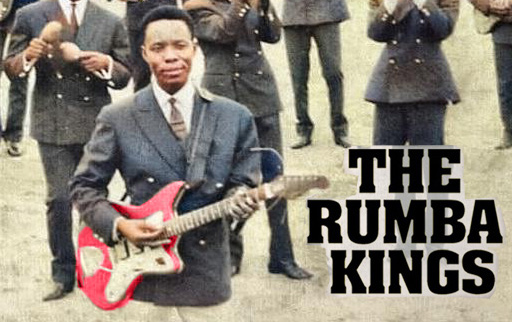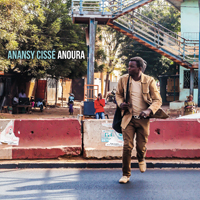
|
A strong return from the Malian desert blues guitarist who began this, his second release, in 2017. He was on his way to a festival in his hometown of Diré in Northern Mali in 2018 when armed men assaulted his band, broke their instruments, and took them hostage. This traumatic experience served to turn Cissé away from music, and it was not until his first child Kady was born that he returned to songwriting. Thinking of his daughter he wrote a song about education, and another about poverty, and while he enjoys the rap music spreading in his homeland he has maintained a mostly traditional sound for his own album. He celebrates his long lineage of marabouts or religious teachers in a song called "Cissé," which has a nice haunting slide guitar-like wail going on in the background. Another great tragedy befell Cissé with the death of his mentor and friend, Zoumana Tereta, who also happens to be my favorite soku (one-string fiddle) player. But we are fortunate that Tereta laid down two tracks for this album in 2017. "Talka (Poverty)" features him in a call-and-response with a female chorus. The production is fabulous, with great studio work augmented by the mixing, done by Cissé himself with the able help of Philippe Sanmiguel. There are two bass players, both called Traoré, and two ngoni players. . |
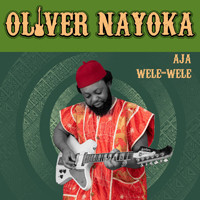
|
Soukous died out in Paris as it became a watered-down imitation of itself — whether it was the musicians aging and slowing down, getting complacent and jaded, or studio effects that ruined the music is hard to say. But then it found a new lease of life in Colombia where the crate diggers and picotero sound-systems reimagined it by mixing it with their own music. Groups like Tribu Baharú emerged to make the soukous sound their own. Then a similar thing happened in Nigeria: the reissue labels had been crazy for "Afro funk," desperately scraping the archives for more and more obscure and less and less compelling discs showing the influence of American 70s music on African's largest country, while contemporary Nigerian music went largely unnoticed in the West. But of course there were always those interested in seeing past that: in Congo there are hundreds of thousands of brilliant but now largely lost recordings from the pre-soukous era (or from WWII to Mobutu), while in Nigeria we always found a strong following for the likes of Nico Mbarga, Oliver de Coque, Chief Stephen Osita Osadebe, Nana Ampadu and his African Brothers and Godwin Opara's Oriental Brothers whose music blossomed after the Civil war over Biafran secession. Now Colombia's distinguished Palenque Records label has reached across the pond and issued a new album of classic Igbo highlife that is a breath of fresh air, or a brisk ocean breeze in the stifling air of Afro-funk, Afro-disco and the rest of that miasma. There is an interesting connection between Nigeria and Congo and that is in the sweet guitar riffing found in the likes of Oliver De Coque and his Congolese counterparts. De Coque apparently learned guitar from a Congolese musician in Nigeria while the great Celestine Ukwu also incorporated the sound into his work. The tracks stretch out in that timeless way, with multiple percussion instruments susurrating underneath like a tropical night full of giant mechanical crickets, a singular guitar lead and smooth lyrics, that we imagine are praising the patrons. Nayoka and his Talented Fellows band of Africa have been performing for over 14 years. Live horns seem like a luxury at this point. His music comes from "passion, practice and consistency" he says. It goes down very smoothly and though it is highly reminiscent of those classic acts I listed above, it is made new in these crisp and clear recordings. .
|
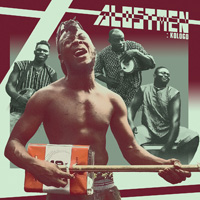 |
ALOSTMEN
TEACH ME (STRUT 234)
The basis of this Ghanaian band's sound is a type of two-stringed lute, called a kologo by the Frafra. This ancient stringed instrument is not traditional looking as it appears to be made from a jerry can and a broom handle. There are two percussionists, one with djembe/talking drum (Aminu Amadu), the other (Sowah) sitting on a gome box, also known in the Caribbean as cajon or rumba box. The kologo is played by leader Stevo Atambire; a second stringed instrument, the goje fiddle, and vocals are handled by Jo Ajusiwine. The music is simple, insistently rhythmical, and compelling. The lyrics which are often in pidgin English are easy to follow: "Everybody bring your dancing shoes/come let's party/I wanna see you move" or "Teach me how to catch fish it is better than you do teach me how to chew fish. Teach me how to hunt meat is better than you do teach me how to chop meat," etc. A truly international fable. The band's leader admits to being into rap, reggae and Malian music as well as his own traditions. The album was recorded on the road, during a tour and various guests dropped in, including highlife legend Gyedu-Blay Ambolley who adds sax and vocals to "Minus me." Wonderfully refreshing. .
|
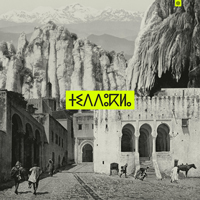
|
HASSAN WARGUI
TIDDUKLA (Hive Mind Records HMRLP013)
Berber banjo is to the fore on this five track album, which features Hassan Wargui backed by a traditional line-up of guembri, tamtam, bendir and krakch (which must be krakrebs?). Personally I find the combination of guembri and krakrebs irresistible; the added banjo really takes it to another level. Hassan grew up in an isolated community in the Anti-Atlas mountains of Southern Morocco, steeped in the art and culture of the Amazigh people (in a time when it was forbidden to speak their Tachelhit language). In his teens Wargui moved to Casablanca looking for work and was able to trade in his home-made instrument for a real banjo. He has collaborated with many other artists, including more modern techno-sounding outfits, but for this project went back to his roots sound. I've heard Moroccan banjo before (on the Arabic Groove CD), but out of context you might think the opening few bars of "Azmz" was Chinese until the singing comes in. Over the course of the 40 minutes, however, it's got the undeniable Atlas mountain groove redolent of sweet mint tea and the incense of kif. . |
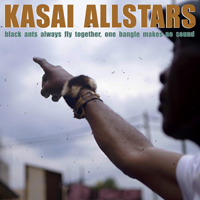
|
KASAI ALLSTARS
BLACK ANTS FLY ALWAYS TOGETHER (Crammed Disc)
Known perhaps for their complex allegorical titles (this one is called "Black Ants Always Fly Together, One Bangle Makes No Sound") as much as their music, Kasai Allstars were a traditional Congolese group who moved to Kinshasa. Initially their music was banned by the Europeans as contributing to lewd dancing, on top of which their ritual dances were seen as satanic. Unusually this collective comes from five different ethnic groups and was rediscovered by Vincent Kenis who went in search of the groups found on the ground-breaking 1978 Musiques urbaines à Kinshasa recordings from OCORA. Some of those bands were still extant, like Konono No 1, but other like the Sankayi group had merged into Kasai Allstars. In 2008 Crammed issued their first disc as Congotronix 3. In addition to guitar and electrified likembes, they've added rudimentary drum machine, programmed by guitarist Mopero Mupemba. Alongside their stalwart vocalist Muambuyi (who inspired & sang in the feature film Felicité), they've added a young singer Bijou who appears on several tracks. As well as remixes by "famous" DJs I've never heard of (Clap! Clap!, Daedelus, and Africaine 808), they've collaborated with actual artists such as Björk, Juana Molina and Questlove. You can imagine, or know, there's an elementary quality to their sound but the production is quite sleek. They are quick to get into a trance-like groove with buzzing likembes on one side and a repetitious riffing guitar on the other. The structure of many of their songs, like "Unity is Strength," reminds me of early Zaiko but they add a dissonant home-made element that undermines this: the buzzing likembes almost sound like raspberries to my preconceived notions of Congolese pop. The synth and guitar are trying their best to seem in control but the undercurrent of drums and percussion swell up to swallow them repeatedly. . |
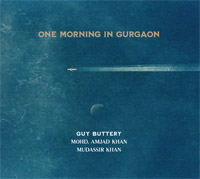
|
GUY BUTTERY, MOHD. AMJAD KHAN, MUDASSIR KHAN
ONE MORNING IN GURGAON (Riverboat Records TUGCD1132)
Guy Buttery is a South African guitar player. Back before Covid shut down the world he was touring India and met the two unrelated Khans (on sarangi and tablas) shortly before their first concert (if the phrase "Delhi traffic" means anything to you, you will understand why they barely had time for a gulp of chai and a handshake before their first concert). However they loved playing together so much they met next morning in the same venue to try and recapture the spontaneity of the night before and recorded this in one session. It's a beautiful recording, and not just mucking about with tried and tested riffs, as clearly the unexpected interaction of the guitar and sarangi are bouncing ideas off one another. The dialogue takes a different turn of phrase when Guy picks up an mbira on "I know this place" and Mudassir starts plucking the sarangi, rather than bowing it. There was not much discussion between the musicians, but bits of Hindi and English explained the structure of each piece before it happened in one take. Music has its own language and spirit and the telepathic bond between these artists is superb. Guy lost ten kilos and returned home a vegetarian but with a newfound deep love for the music of India. Indeed he goes outside himself on the two ragas, which are ten minute improvisations; on the second one, "Raag Kirwani," he seems to draw strength from the spirit of Hans Reichel (the German guitarist) when he relishes the sounds of struck rather than plucked strings. . |
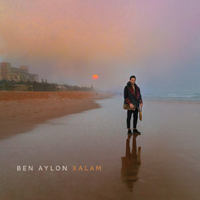
|
This is remarkable: Ben Aylon is an Israeli musician who traveled to Dakar seven years ago to study the traditional sabar drum, with the son of the great Doudou Ndaiye Rose as his teacher. He became so proficient he was soon gigging with the likes of Youssou Ndour. He developed a technique for playing ten drums at once, to make the sound of a whole troupe of drummers! He was greatly influenced by the takamba ceremonial music of Gao. He then went on to study ngoni, xalam (another ancient stringed instrument) and other traditional West African instruments. His one man show was televised in Senegal and led to him performing with Cheikh Lô (an incredible drummer himself), Omar Pene and Doudou Ndiaye Rose. For his debut album Aylon plays the xalam, as well as sabar, various ngonis, synth and electric bass. He explains the reason for the title of his album: the word is also the root of the Hebrew word for "dream." The line-up is as impressive as Aylon's career, for he managed to record two separate Malian divas as he encountered them in his travels. Amy Sacko sings "Alafia" (recorded in Gibraltar) and he recorded the late Khaira Arby in a hotel room in Worms, Germany, in 2015. His third diva, is Aviva, an Ethiopian singer, stretching the sound across Africa to the East coast. The tracks with these guest vocalists are exceptional, like he is flexing every muscle to come up to their level. This is another great discovery from Riverboat. . |
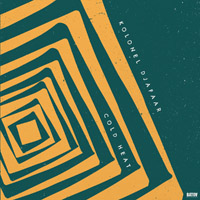
|
KOLONEL DJAFFAR
COLD HEAT (Batov Records BTR050)
Kolonel Djaffar showed up on Bandcamp and, as usual, there is no info to go on. A quick search turns up their facebook page. So they appear to be nine young Belgian guys who are jazz musicians with a funky Afrobeat drummer, and a keyboardist (Farfisa) with a taste for Ethiopian chords. I trust Bandcamp recommendations, for the most part, and felt this stood out. There is a good balance of brass, reminiscent at times of Bollywood Brass Band (!) from London, but with the added bass, guitar and drums. Also trombone and baritone sax are deeply resonant, giving oomph to the bottom end of their mysterious and intriguing melodies. Oddly — though they have nothing in common — they also evoke Dengue Fever: I guess it's the mix of keyboard and 70s-rock electric guitar. What we are seeing/hearing is infinite hybridization of "world music" sounds as different groups in different countries approach elements of it, and incorporate instruments and rhythms that work well for them. Back in my punk and new wave days I followed a band called Tuxedomoon who played the clubs in San Francisco; they moved to Belgium after they got a recording contract with Crammed Disc, and never returned. I wonder if their influence lingered, because I get a sense of their moody theatrical approach to the music here. Cold Heat starts with an ominous horn build-up over serious kicking drums, then after a snaky echoey guitar phrase the eerie mysterious organ floats in and a trombone solo persuades us that "Bactrian camel" is indeed the subject. The guitar phrase starts to repeat, the organ too, and then brass layers up the dust storm to a big climax. "Lamentation" is equally tight, suggesting lots of live gigs before they laid it down: this time the Ethiopic organ starts out, followed by a staggered drum pattern before confident charging horns state their intent. "The Heist" even introduces a keyboard pattern that reminds me of gamelan music, adding another musical layer. This is a 16-minute EP, I can't wait to hear more. . |
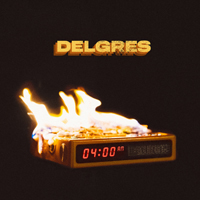
|
DELGRES
4 ED MATEN (4 00 AM) (Delgres Music)
Delgrès deliver another great mixture of blues rock with some sophisticated production, taking their pan-Caribbean sound from New Orleans to Guadeloupe via Paris and bringing it into a global focus. The leader is singer-songwriter Pascal Danae who plays guitar. The band is named for Louis Delgrès, a Creole officer who led an uprising against Napoleon in the Caribbean in 1802. He blew himself up rather than surrender and ironically he has a memorial facing Toussaint L'Ouverture in the Panthéon in Paris. (The irony is they were both victims of the French state.) Though France is now a post-colonial country the effects of empire are still felt and Danae's songs assess the current situation in terms of immigrants struggling, separation, racism and slavery. When he was 30, Danae returned to his ancestral home of Guadeloupe and saw his ancestors' emancipation proclamation dated 1841. This brought things into clearer focus for him. He took his passion for guitar to London where he became a session musicians working with Peter Gabriel, Youssou, Gilberto Gil and others. The New Orleanian element comes through the rhythm section of Baptiste Brondy on drums and Paris conservatory-trained RafGee on sousaphone, instead of bass. The hard big boom production does recall some of Peter Gabriel's more bombastic rock efforts. See "Assez Assez" which retains a Caribbean lilt. "L'ecole" is out and out balls to the wall rock and roll, before they return to a down-home blues/rock groove on "Lese mwen ale," which, if my Kriyo serves me right means "Let me go." . |
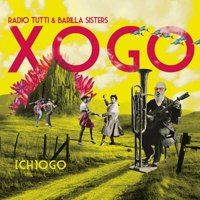
|
Tutti is Italian for everything. As a musical direction it means "all together now," and that's what you get here. The Tuttistas: Baptiste Sarrat (on brass), and Pierre-Alexis Lavergne (on keyboard, guitar, percussion, bouzouki, etc) have teamed up with the Barilla Sisters: Pauline Riviere (on maracas, melodica, tambourine) & Judith Chomel (on accordion, tambourine, etc) and they all sing and dance, whoop and party. Bass clarinet, sax and violin show up from time to time as guests. Their home is Galicia (in Northwestern Spain, where Celts once inhabited the coast) and their music could be loosely termed traditional folk music from southern France and northern Spain, but it is infused with electricity, and doses of Creole (from the Caribbean) as well as "Oriental" (Eastern European) and pan-Mediterranean sounds. The anchoring device is female voices, high and accompanied by slapped pandeiretas, but it is really genre-defying in its scope. There's a Brasilian forro melody (with rap) and an Italian song thrown in for good measure. Xogo (pronounced "shogo") is the Galician word for play. Jogo is game in Portuguese (& Esperanto) and the fun crackles off this disc. The band abounds in talent. I have been enjoying their creative videos on Youtube, such as 2019's "Pizzicarellafro mia," and "Rumba Morena," the lead track from this new album. . |
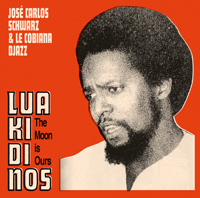
|
JOSE CARLOS SCHWARZ & LE COBIANA DJAZZ
LUA KI DI NOS (Hot Mule)
"The Moon is Ours" is the English translation of the title and yes, dream big, folks and your dreams may come true. This is the cream of two records Schwarz made with Cobiana Djazz in the mid-1970s. They are both imbued with that dreamy Guinean lilt: washes of sound from electric guitars and punchy horns and heartfelt vocals. Schwarz was of mixed parentage, Cabo Verdean and German ancestry, with Guinea-Bissau as his place of birth. He studied in Dakar and Lisbon and took up poetry and music against his father's wishes. In the 60s he liked Brasilian Bossa Nova and American soul & jazz music, but was also drawn to the political struggle for independence from Portugal in his homeland. He turned inward to indigenous melodies and began writing in Guinean creole and, around 1970, got together with Aliu Bari and Mamadou Ba to form Cobiana Djazz. Their style of music, which had mostly been underground until that point, was met with overwhelming public acclaim. Their roots revival music was also seen as a weapon of resistance as they recorded in secret and smuggled tapes to the radio. However the group members were arrested in connection with a bombing in 1972 and spent two years in prison. Once independence was attained, following a Socialist revolution in Portugal, Schwarz was not only freed but appointed Minister of Arts and Culture in charge of youth policies! But ever the poet and revolutionary, he became an embarrassment to the government, so they posted him to Cuba under the pretense of setting up diplomatic relations. Tragically his plane crashed on landing in Havana killing all passengers. Schwarz was 27. If you love Lusophone rock from the 70s, such as Super Mama Djombo or Zé Manel, you will adore this. Two songs by Schwarz (not included here) appeared on the crucial Memorias de Africa compilation from Farolmusica in 2008. This disc (which is listed for 150 euros on discogs) and the sequel, vol 2, appeared from SonAfric in 1978; the same year a recording he made with Miriam Makeba was released as "Djiu di Galinha." Scanning the track lists compared to discogs there appear to be five songs from volume one (half of that album) and six of the eight on volume two here. Unless they've changed the titles drastically (the old "Amigos Cabali" has become "Amigus ka bali," etc), it would seem there are at least seven more yet to reappear.
. |
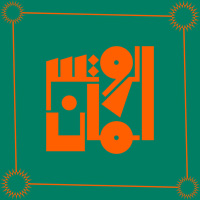
|
THE ROOTSMAN
ESSENTIALS 1996-8 (Akuphone 1030)
This is a two-LP set by The Rootsman, the nom-de-pseud of John Bolloten, a white kid from Brighton England, who grew up on punk before getting a job in a record store in Bradford called Roots Records that specialized in Reggae and Dub. Bolloten began experimenting with DIY sound equipment and then in 1993 someone turned him onto Rai and he immersed himself in that genre. By 1995 he was in Egypt and Morocco where he met Aisha Kandisha's Jarring Effects and began remixing their music for release on his own label. In 1997 he converted to Islam and began collaborating with an artist known as Muslimgauze (Bryn Jones). His punk roots inspired the fury of his pro-Palestinian activism (which, I believe, we all applaud). While he not alone in applying dub techniques to arab music, he does it exceptionally well. This double album is drawn from four of his LPs, Into the Light, 52 Days to Timbuktu, Union of Souls with Celtarabia, and Distant Voices which featured the Disciples as Pachakuti. It is quite mesmerizing. If you like Big Men: Rai meets Reggae or Gaudi's reworking of Nusrat, Dub Qawwali, the work of Cheb i Sabbah or the Spy from Cairo, you will enjoy this. The first side is the most interesting, being the most agitated, then it becomes more mellow after his conversion. Indeed the 1996 album Into the Light, whose first three tracks are included, is replete with catchy hooks, inventive drum patterns, and intriguing vocal samples. The later albums, like Distant Voices show more of the African Head Charge vibe that Adrian Sherwood brought to the UK throughout the 1980s and 90s. By side four it's quite soporific. . |
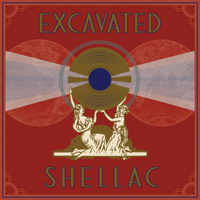
|
EXCAVATED SHELLAC
AN ALTERNATE HISTORY OF THE WORLD'S MUSIC (Dust2Digital)
The first time I was overcome with "antiquarian lust" for 78 rpm shellac discs was about 30 years ago, in Powell's bookstore in Portland, Oregon. In the record room, they had a whole section devoted to 78s. I started looking through the neatly categorized albums, seeing Ambrose, Basie, Cab Calloway, Duke Ellington, and thought for a moment I was about to embark on a new area of collecting. Then it occurred to me, all the things I recognized I already had on much more convenient formats, like LP & CD. In time the shellac past is returning in other formats, like this rich 4-"disc" set from Excavated Shellac. It's another triumphant assemblage by Jonathan Ward who gave us the stunning Opika Pende: Africa at 78. And again it has a beautifully designed, legible package, crammed with ephemera, photos and graphic goodies. When it comes to "world music" in general and globally speaking, I am as ignorant as the next fellow. I like African music and music of the Black Diaspora. I also like gypsy music, and some music from the Indian subcontinent, but I am oblivious to Irish, Scots or Breton fiddle or bagpipe music (even though it's "in my blood": my ancestors stretching back to Ireland were fiddlers and singers), because generally the four-square rhythms don't engage me. Speaking, obliquely, of Northumbrian small pipes, there's a tune here: "The Keel Row," which I will sing for you if you buy me a pint (For two pints, I will also sing "Bobby Shaftoe"; for three pints I promise to stop). It's a 1929 recording by legendary Northumbrian piper Tom Clough. There are few artists I know on Excavated Shellac, like San Salvador from the Congo and Salim Abdullah of Tanzania, but it's mostly new to me. The liner notes, which are thorough and document every track in depth, point out the superiority of the recordings on the local Mzuri label as Abdullah's track, "Kwaherini (goodbye)" demonstrates. Abdullah, who formed the Cuban Marimba Band, is justly celebrated and this track is not on the LP which came out in 2019 from Domino Sound, so it's a treat. Similarly the banjo track from Nyasaland (Malawi) is the unique known copy of this recording on the Federal label. The great pioneer Hugh Tracey was making inroads into the territory on behalf of Gallo, looking for such acts. Federal, probably run by Indians (those with dots, not feathers), had their records pressed in Bombay! Surprises to my ears are "Riak-Riak" by Toba Batak Ensemble from Sumatra and Vassyl Yemetz's "Z Ukrainskyce Stepiw" from Ukraine. This is not the kind of disc you put on and listen to all the way though, as it doesn't seem to be sequenced thematically and some of it is harsh. Before the introduction of microphones in late 1920s recordings tended to be loud. But the seemingly odd juxtapositions work occasionally. A sequence of tracks from India, Iran, Uzbekistan, Malaysia and Albania flows nicely. The Malay fiddler would be at home in the Urals we suspect.
Ward admits his collection, like his blog, also called Excavated Shellac, is only a building block and not a definitive canon. There were so many hundreds of thousands of shellac discs released and while most vanished, many still turn up. So if he has found one disc by say, Valentin Eugenio, a folk singer from the Philippines, it's good but not necessarily the best of the dozen sides he recorded in 1931. We just don't know. We do know that popular songs like "All by yourself in the moonlight" by Whispering Jack Smith have not worn well a century later. And if it had not been for black musicians, we'd still be dancing the foxtrot. The album ends with a Cuban son: the timeless elegance of the sublime "Son la dos, China (It's two o'clock, my china)" by Sexteto Habanero. [Footnote: "China" is also cockney slang for mate, as in China plate!] It stops abruptly as if to say we could keep on playing for ever... or put another way, once more from the top. . |
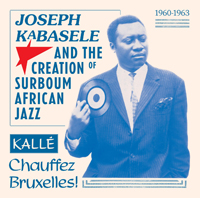
|
GRAND KALLE & AFRICAN JAZZ
JOSEPH KABASELE AND THE CREATION OF SURBOUM AFRICAN JAZZ (Planet Ilunga PI09)
This is not just a great double album of music, it's also an important historical and cultural document. For years we only knew the music of Joseph Kabasele, "le Grand Kalle," through the Sonodisc reissued LPs and CDs which infamously had no liner notes beyond the titles of songs. The Planet Ilunga label has been methodically recovering the first recordings of the music of Congo's early superstars, Franco and Nico, as well as Joseph Kabasele and the seminal groups African Jazz and Rock-a-Mambo. I have a baker's dozen CDs by Grand Kalle and his various groups, on Sono, apart from one on Syllart, and two on Gefraco. One on Sono, Grand Kallé and l'African Team, is even dated 1667-1970, showing their longevity! Eight tracks came from Surboum African Jazz, which is the label featured in this latest Planet Ilunga issue covering the period 1960-63. Then the first important collection came from Stern's in 2013 with Ken Braun's 2-CD set Le Grand Kallé: His life, his music which cherry picked the best of his career including a dozen tracks from the Surboum sessions, along with the crucial "Indépendance cha cha" and 'Table ronde."
This is a companion and sequel to the first Planet Ilunga album Souvenirs from the Congo, also 2013, which presented 26 tracks that spanned the entire career of Grand Kallé. As presented by Planet Ilunga the music and the documentation in this new collection are intertwined and dovetail to give you a rewarding understanding of the conditions under which the music was recorded and a snapshot of that moment in the career of these many hugely talented musicians. There are contemporary newspaper articles, many photos and even a discography of the African Jazz labels.
1960 was a crucial year for the Congo, for in the winter of that year a delegation of politicians negotiated the country's independence from Belgium in Brussels. As the discussions in the cold capital went on, the Congolese delegates had the idea of importing a band to warm up their evenings ("Chauffez!"), and Kabasele was invited by a newspaper owner to put together a supergroup drawing from his own band and that of his rival Franco's. A superfluity of guitarists meant Armand Brazzos, who came from OK Jazz with singer Vicky Longomba, had to switch to double bass and learn it in three days, and a young 18-year-old percussionist named Petit Pierre was also drafted into their ranks. Once in Belgium they picked up a white jazz drummer Charlie Hénault. In Europe the band spent three months touring to expanding and ecstatic audiences. They had to turn down offers to tour as far away as Russia as fans rented buses to follow their gigs from Belgium to Paris and beyond. They had an afternoon gig at an upscale department store and evening gigs in clubs as well as the hotel where the politicians were staying. The entire story is told with many wonderful newspaper articles, featuring previously uncollected, marvelous photos of the band performing. Despite the existence of this archival material, including newsreel footage of the band, the story has been muddied by time. Now we get the complete timeline and an almost day-by-day account of the band's trips.
The story is told by two experts: Alan Brain the film-maker whose documentary The Rumba Kings, which also recreates the Table Ronde concert, was released to wide acclaim in Summer 2021, and label-owner Bart Cattaert who fills out the story of the first African-owned and operated record label. After their return to Congo, and still ostensibly under contract to Esengo, Kabasele explained how he wanted to spread his music beyond Congo and with the backing of the newspaper and connections to Fonior studios, he returned to Belgium with a full band to record. The group included Roger Izeidi on maracas, the Baroza brothers on guitars, along with Damoiseau and Casino on guitars, Edo Lutula on vocals and clarinet: the last three from another group Jazz Africain. But where are Nico and Dechaud, you ask? They decided to stay with Esengo and released 18 singles under the name African Jazz aile Nico (the Nico wing). Back in Brussels Kalle added Camerounian sax player Manu Dibango to the formation. The two wings of the group were reconciled in 1961 when it was clear Nico was not a charismatic lead vocalist and the substitute guitarists in the mother-band were not that distinctive as soloists. Another trip to Brussels also revealed the emerging talents of the young singer Rochereau along with the restored band at full strength. Their great tunes, like "Africa mokili mobimba," "Kamulanga" and "Matata masila na Congo" were recorded on this visit. The band allegedly composed in the studio and played all day and night, sometimes passing out from fatigue or hunger. Manu Dibango in his autobiography complains about their "African sense of time" where a lot of messing about is followed by a one-take session. Maybe this is to excuse his sometimes feeble sax playing on these tracks; on the other hand his piano playing is very good, notably on the Latin numbers. As well as spontaneous composition, they drew from their broad repertoire and covered Dizzy Gillespie ("Wachiwara"), Don Alfonso ("Batucada") and even some South African tunes ("Mutatsi ya yombo"). Dibango returned to the Congo with the band (including Charlie Hénault) and with his own band African Soul, introduced the "Twist à Leo," one of five Dibango numbers included here, as they too recorded on the label showing it was a real commercial enterprise and not merely a vanity project. Along with the African Jazz tracks we know (from the previous Planet Ilunga album, Sono CDS36543, and 36582, as well as the Stern's set, Le Grand Kallé: His life his music) we now get 24 largely unknown numbers to give the bigger picture of what this group was all about. Interestingly it seems to be about experiment and diversification with some fine stretching out. Not all the tracks are "rumba Congolaise" by any means. There are many Cuban styles, charanga, cha cha, guaguanco, and on some of these Dibango plays piano but the horn part is taken over by a second-rate trumpeter. There are also ersatz Cuban numbers in nonsensical Spanish, such as Rochereau's "Oyeme querida" and "Pasie die senorita" and "Amor perdido" as well as "Luna nokera" by Mujos, presumably meant to be "No quiero la luna." On the praise song for Louis Armstrong "Satchmo okuka lokole" we hear Edo Lutula on clarinet. Outstanding is their cover of Enrique Jorrin's "Cuidado con la mano," covered as the nonsensical "Guidado colamano." On "Ambiance" Kalle shows off his crooner stylings in the manner of Corsican operatic tenor & film star Tino Rossi. It's a very French cabaret sound redeemed by Nico's guitar dancing around the melody. Nico also stars on his brother's composition "Bana ya nwa" a favorite of mine along with "Georgette ya ndeko," and, well, anything with Nico playing on it! We go back to South Africa for a jive version of "the Lion sleeps," by Dibango, with a more considered sax solo, and another twist called "Hallelouia," with Dibango to the fore. To me these Dibango tracks are extraneous, but, as I say, they help give a larger picture of the label's scope. . |
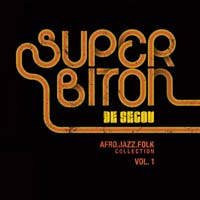
|
SUPER BITON DE SEGOU
AFRO JAZZ FOLK COLLECTION VOL 1 (Mieruba-ML)
This is one of the great Malian big bands of the 70s. Founded in 1966, they were four time winners of the biennial youth music competition with their electrified folk music performed by two singers with trap drums, congas, four guitarists and plenty brass (two trumpets, two saxes, flute). In 1970 they not only beat out the bands from the six other regions of Mali, their members also took top honors for best guitar, trumpet, composer, etc. Their home town Ségou was the capital of the Bambara empire in the 16th century. The Bambara beat swings harder than traditional Malinké music, with conga drums prominently driving the rhythm. After colonialism the young bands wanted to escape from the tangos, beguines and charlestons which their elders had been playing, though they had absorbed some smart ideas from Duke Ellington and other American arrangers. Band-leader is trumpeter Amadou Ba and he is assisted by saxophonist Abou Touré. In the 80s Zoumana Diarra was their drummer on a couple of great albums issued by Bolibana. Here they present a whole array of styles with some classic dreamy numbers that stretch out, in addition to the uptempo danceable tracks. "Bwabaro" is a repeat of that rocking number from "Afro Jazz du Mali" (Bolibana 40, 1986) while the closer "Garan" appeared on a 1977 Syllart album with a generic title (For some reason it's slower here than on the Syllart issue). All other tracks have previously only appeared on cassette in Mali. There are a few moments of tape flutter that could perhaps have been judiciously edited out, but presumably these tracks found on cassette are the best available copies. . |
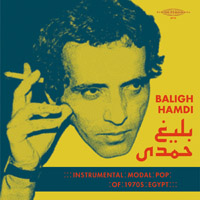
|
I didn't think I would get into this, but it's completely entertaining. Yes, there's the expected Egyptian instrumentation of flutes, violins, clay drums, and synths, but also a dose of Bollywood to make it amusing. The 2 LP set is a distillation of 6 or more LPs by Hamdi who started out learning violin as a lad. He is reckoned a key figure in not only modernizing Egyptian and by extension Arabic music but in bringing it to the wider world. Just as pan-Arabism took hold in the 60s and novelists like Nobel prize-winner Naguib Mahfouz were making their mark, Hamdi turned away from his classical training to study accordion, and brought drum kits and saxes into the studio for his compositions. Once guitars added their own twist to quarter-tone Arabic scales, people began to notice. Umm Kulthum recorded one of his earliest songs, propelling him to popular attention. In addition to pop songs he wrote many soundtracks for movies and soap operas, and it is those instrumentals we hear on this selection, including a weird cover of the theme from "Love Story." Hamdi brings in a sitar (the Bollywood connection) and it works well in counterpoint with a dulcimer. There's also a theramin to get some creepy vibes going in conjunction with his Casio keyboard. His studio group, the Diamond Orchestra, included guitar, organ, sax and an accordion which was modified for quarter-tone scales. With many two minute or 90-second cuts interspersed with longer themes, there's variety and grooves aplenty to make this a delight-filled aural trip. . |
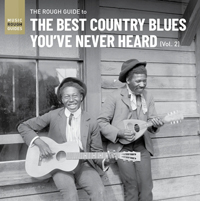
|
ROUGH GUIDE TO THE BEST COUNTRY BLUES YOU'VE NEVER HEARD VOL 2 (RGNET1414CD)
Rough Guides to the Blues continue at breakneck speed with another volume dedicated to Country Blues, a convenient catchall title for any of the regional blues styles of a century ago. In keeping with the subtitle of "Best you've never heard," Neil Record, the compiler, has assembled two dozen obscure but great tracks, all lovingly remastered to best-possible sonic clarity, to demonstrate that this was a remarkable flowering of (mainly) African-American musical talent between the Depression and World War II. The names are obscure, though sometimes amusing — Bogus Ben, Skoodle Dum Do & Sheffield — but the tunes are occasionally familiar, from "Careless Love" to "Stack O'Lee" to "Nobody knows you when you're down and out." This musical well was a source for Canned Heat, Country Joe & the Fish and other sixties American rock bands, so there are many familiar phrases and riffs. Edward Thompson's "Seven Sisters Blues" sounds like another version of "Rolling & Tumbling." Bogus Ben is accompanied by banjo, mouth organ and kazoo; I wonder if he knew the (original) Rooftop Singers who used the same instruments. Bogus Ben pretended to be blind while busking, hence the "bogus" appellation, and also performed on a mandolin-banjo, which sounds interesting. Another surprise is the stellar clarinet on Will Day's "Sunrise Blues." There are novelty numbers, like "Travelin' Man" and the fake gospel of "G. Burns is gonna Rise again," along with a great rendition of "Easy Winner" by the Blue Boys which is a string arrangement for guitar and mandolin of Scott Joplin's "The Entertainer." It was a famous piano rag, especially after it was sold on pianola rolls in the 1910s, but (wikipedia tells me) this was the first recording. Virgil Childers' "Travelin' Man" evoked the story songs of Randy Newman, suggested long continuity in American singer-songwriters. The various Blues comps flow out in all directions like a spilled drink, sometimes reshuffled and repackaged on vinyl (e.g. for "Record Store Day"), other times in the impermanent CD format. Other than a need for some liner notes, the Rough Guide series is exemplary. . |
 |
ONE NIGHT IN PELICAN
AFRO MODERN DREAMS 1974-7 (Matsuli Music MM125)
If you lived in South Africa in the 1970s and hankered for a bit of nightlife you might find yourself at Club Pelican, Soweto's first nightclub. This album recreates the epitome of what you might have encountered in this spot, which was definitely on the wrong side of the tracks, with a sample of groups playing Soul, Funk, Disco and Jazz. I am trying to remember concerts I went to the in the 1970s, living here in California, and remember Mahavishnu Orchestra, Pharoah Sanders, Dexter Gordon, Roland Kirk, McCoy Tyner, Captain Beefheart and a ton of rock and roll acts from the Pretenders to Ian Dury & the Blockheads opening for Lou Reed — but of course most of those bands did not tour to South Africa. (Remember "I ain't gonna play Sun City"!?) Instead we hear here bands called The Black Pages, The Drive and The Headquarters. The jazz tracks are engaging; the Disco one sucks, like all disco. Standouts include "Pelican Fantasy" by jazz Ensemble of Rhythm and Art, featuring Khaya Mahlangu on tenor and Dennis Mpale on trumpet. It's an interesting mix, and most of it instrumental. Lyric content was censored to avoid anyone getting in oblique criticisms of the Apartheid government. The Shyannes' sound is sophisticated in a Commodores kind of way; Almon Memela's Soweto perform "Pelican City" with a driving Booker T-like organ and massed "Tower of Power" horns. It's hard not to compare them to better-known American acts as it seems they are all trying to sound like they are from Detroit, Chicago or Philadelphia. But their rotating presence in this one club drove them to high levels of competition and quality playing. My favorite band, who backed Mahlathini, are here as Makhona Zonke Band with Teaspoon and West Nkosi on alto saxes, Marks Mankwane on guitar, Joseph Makwela, bass, and Lucky Monama on drums. Other luminaries of the scene appear here and there, including sax player Duku Makasi, keyboard player Bheki Mseleku, and bassist Sipho Gumede. Skip the disco track and you have some fine, sharp playing. And, as usual with Matsuli, the remastering is flawless, giving crystal clear audio, and the packaging with rare photos and histories is impeccable.
.
|
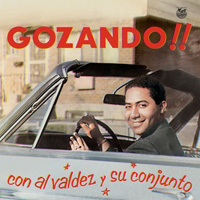 |
ALFREDITO VALDEZ JR Y SU CONJUNTO
GOZANDO!! (Vampisoul VAMPI220LP)
Al Valdez (as he is called here) is the son of another Alfredo Valdés, a Cuban singer with Septeto Nacional, whose family emigrated to New York in 1956. When he was 18, Alfredito (Little Alfie) joined the conjunto of Arsenio Rodriguez, another Cuban expatriate and the pivotal figure in the development of Latin music. Two years later, in 1961 Alfredito joined Ray Barretto's Charanga Moderna as the salsa music pioneered by Arsenio took hold in the US. He still played with Arsenio, and picked up gigs with Tito Puente and Machito's bands. In winter 1964, Machito brought him along on a South American tour, but as often happens in these junkets, the Argentine promoter forgot to pay them and they were stranded in Lima, Peru, running up a hotel bill they couldn't pay. Trumpeter and arranger Mario Bauza (Machito's brother-in-law), flew back to New York to raise the money to repatriate the band but they were on the verge of starvation, so ever-resourceful Alfredito approached MAG records' owner and asked if he'd like them to cut a couple of discs at bargain prices. The result became one of the lost grails of salsa, since few copies made it out of Peru (there's no listing on discogs, though some singles from the second disc show up there). I don't have info on the personnel other than Alfredito plays piano and you can hear "Chocolate" Armenteros on lead trumpet in a driving set of pachanga, mambo, guaracha and descargas. Brew Moore had left the line-up in the fifties but his influence can he heard on the sax player. Herbie Mann had also moved on but there's a good flautist holding his own. The opener is really exciting, with powerful timbales, but fades out at the three minute mark, and then they perform Tito Puente's "Aprieta" which became a pop hit a decade later as "Oye como va." The big band sound is in full effect on the bolero "Si me pudieras querer," a Bola de Nieve (Ignacio Villa) ballad normally performed by Graciela (whom I guess did not tour with them). I checked some of the contemporary Machito albums to see if they duplicated material, but they seem to have had a lot of tunes in their repertoire. There's even a Colombian cumbia to appeal to the locals: the romping "Tabaquera." Sadly none of the tracks exceeds 3 minutes; still it's a gem from end to end. Alfredito went on to have a successful career, but notably (from my point of view), he was producer and arranger of the Lassissi sessions (a forerunner of Africando) when African salseros, such as Laba Sosseh, Amadou Balake, and Doh Albert, came to New York in 1979 and sang with real salsa musicians backing them. He later toured with Cachao and always had legendary buddies he could call on for recording dates.
.
|
